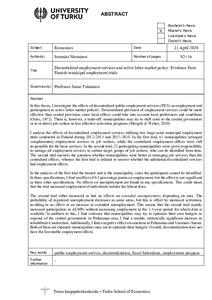Decentralized employment services and active labor market policy : Evidence from Finnish municipal employment trials
Nieminen, Jeremias (2020-04-22)
Decentralized employment services and active labor market policy : Evidence from Finnish municipal employment trials
Nieminen, Jeremias
(22.04.2020)
Julkaisu on tekijänoikeussäännösten alainen. Teosta voi lukea ja tulostaa henkilökohtaista käyttöä varten. Käyttö kaupallisiin tarkoituksiin on kielletty.
avoin
Julkaisun pysyvä osoite on:
https://urn.fi/URN:NBN:fi-fe2020050725623
https://urn.fi/URN:NBN:fi-fe2020050725623
Tiivistelmä
In this thesis, I investigate the effects of decentralized public employment services (PES) on employment and participation in active labor market policies. Decentralized provision of employment services could be more effective than central provision, since local offices could take into account local preferences and conditions (Oates, 1972). There is, however, a trade-off: municipalities may try to shift costs to the central government or to or direct job seekers to less effective activation programs (Mergele & Weber, 2020).
I analyze the effects of decentralized employment services utilizing two large-scale municipal employment trials conducted in Finland during 2012–2015 and 2017–2018. In the first trial, 61 municipalities arranged complimentary employment services to job seekers, while the centralized employment offices were still responsible for the basic services. In the second trial, 23 participating municipalities were given responsibility to arrange all employment services to certain target groups of job seekers, who can be identified from data. The second trial answers the question whether municipalities were better at arranging job services than the centralized offices, whereas the first trial is utilized to answer whether the additional decentralized services had employment effects.
In the analysis of the first trial the treated unit is the municipality, since the participants cannot be identified. In three specifications, I find an effect of 0.5 percentage points on employment, but the effect is not significant in three other specifications. No effects on unemployment are found in any specifications. This could mean that the trial increased employment of individuals outside the labour force.
The second trial either increased or had no effects on extended unemployment, depending on area. The probability of registered unemployment decreases in some areas, but this is offset by increased activation, resulting in no effect or an increase in extended unemployment. This means that the second trial mainly increased participation in ALMPs without increasing employment in the 1.5-year period for which data is available. In addition to this, I find evidence that municipalities may try to optimize their own budgets in expense of the central government: in Pirkanmaa area, I find a sizable, statistically significant increase in rehabilitative instruction. Additionally, I find a negative effect on sanctions in Pirkanmaa and Varsinais-Suomi. Both of these are channels municipalities may use to optimize their budgets. Overall, decentralization does not have favourable employment effects.
I analyze the effects of decentralized employment services utilizing two large-scale municipal employment trials conducted in Finland during 2012–2015 and 2017–2018. In the first trial, 61 municipalities arranged complimentary employment services to job seekers, while the centralized employment offices were still responsible for the basic services. In the second trial, 23 participating municipalities were given responsibility to arrange all employment services to certain target groups of job seekers, who can be identified from data. The second trial answers the question whether municipalities were better at arranging job services than the centralized offices, whereas the first trial is utilized to answer whether the additional decentralized services had employment effects.
In the analysis of the first trial the treated unit is the municipality, since the participants cannot be identified. In three specifications, I find an effect of 0.5 percentage points on employment, but the effect is not significant in three other specifications. No effects on unemployment are found in any specifications. This could mean that the trial increased employment of individuals outside the labour force.
The second trial either increased or had no effects on extended unemployment, depending on area. The probability of registered unemployment decreases in some areas, but this is offset by increased activation, resulting in no effect or an increase in extended unemployment. This means that the second trial mainly increased participation in ALMPs without increasing employment in the 1.5-year period for which data is available. In addition to this, I find evidence that municipalities may try to optimize their own budgets in expense of the central government: in Pirkanmaa area, I find a sizable, statistically significant increase in rehabilitative instruction. Additionally, I find a negative effect on sanctions in Pirkanmaa and Varsinais-Suomi. Both of these are channels municipalities may use to optimize their budgets. Overall, decentralization does not have favourable employment effects.
